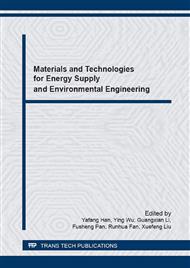[1]
K. Q. Peng, Y. Xu, Y. Wu, Y. J. Yan, S. T. Lee, J. Zhu, Aligned Single-Crystalline Si Nanowire Arrays for Photovoltaic Applications, Small, 1 (2005) 1062-1067.
DOI: 10.1002/smll.200500137
Google Scholar
[2]
E. C. Garnett, P. D. Yang, Silicon Nanowire Radial p−n Junction Solar Cells, J. Am. Chem. Soc. 130 (2008) 9224-9225.
DOI: 10.1021/ja8032907
Google Scholar
[3]
Y. Cui, Q. Wei, H. Park, C. M. Lieber, Nanowire Nanosensors for Highly Sensitive and Selective Detection of Biological and Chemical Species, Science 293 (2001) 1289-1292.
DOI: 10.1126/science.1062711
Google Scholar
[4]
V. Lehmann, H. Föll, Formation Mechanism and Properties of Electrochemically Etched Trenches in n‐Type Silicon, J. Electrochem. Soc. 137 (1990) 653-659.
DOI: 10.1149/1.2086525
Google Scholar
[5]
T. Matsumoto, M. Maeda, J. Furukawa, W. B. Kim, H. Kobayashi, Si nanoparticles fabricated from Si swarf by photochemical etching method, J Nanopart Res (2014) 16: 2240.
DOI: 10.1007/s11051-013-2240-y
Google Scholar
[6]
J. Yooa, G. Yua, J. Yib, Large-area multicrystalline silicon solar cell fabrication using reactive ion etching (RIE), Sol. Energ. Mat. Sol. C. 95 (2011) 2–6.
DOI: 10.1016/j.solmat.2010.03.029
Google Scholar
[7]
S. Y. Li,W. Ma, Y. Zhou, Fabrication of porous silicon nanowires by MACE method in HF/H2O2/AgNO3 system at room temperature, Nanoscale Res. Lett., 9 (2014) 196.
DOI: 10.1186/1556-276x-9-196
Google Scholar
[8]
S. Y. Li,W. Ma, Y. Zhou, Fabrication of p-type porous silicon nanowire with oxidized silicon substrate through one-step MACE, J. Solid State Chem. 213(2014) 242–249.
DOI: 10.1016/j.jssc.2014.02.037
Google Scholar
[9]
K. Liu, S. Qu, F. Tan, Y. Bi, S. Lu, Z. Wang, Ordered silicon nanowires prepared by template-assisted morphological design and metal-assisted chemical etching, Mate. Lett. 101 (2013) 96–98.
DOI: 10.1016/j.matlet.2013.03.086
Google Scholar
[10]
Z. Huang, N. Geyer, P. Werner, J. Boor, U. Gösele, Metal-Assisted Chemical Etching of Silicon: A Review, Adv. Mater. 23 (2011) 285–308.
DOI: 10.1002/adma.201001784
Google Scholar
[11]
H. Zhang, M. G. Han, P. Zheng, L. Zheng, H. B. Qin, Porous silicon templates prepared by Cu-assisted chemical etching, Mater. Lett. 118 (2014) 146-149.
DOI: 10.1016/j.matlet.2013.12.093
Google Scholar
[12]
C. Chartier, S. Bastide, Metal-assisted chemical etching of silicon in HF–H2O2, Electrochimica Acta, 53 (2008) 5509-5516.
DOI: 10.1016/j.electacta.2008.03.009
Google Scholar
[13]
K. S. Nahm, Y. H. Seo, H. J. Lee, Formation mechanism of stains during Si etching reaction in HF–oxidizing agent–H2O solutions, J. Appl. Phys. 81 (1997) 2418.
DOI: 10.1063/1.364248
Google Scholar
[14]
Z. R. Smith, R. L. Smith, S. D. Collins, Mechanism of nanowire formation in metal assisted chemical, Electrochimica Acta. 92 (2013) 139-147.
DOI: 10.1016/j.electacta.2012.12.075
Google Scholar


